Aulnay-sous-Bois
| Aulnay-sous-Bois | ||
|---|---|---|
|
Town hall | ||
| ||
 Paris and inner ring departments | ||
| Coordinates: 48°56′19″N 2°29′26″E / 48.9386°N 2.4906°ECoordinates: 48°56′19″N 2°29′26″E / 48.9386°N 2.4906°E | ||
| Country | France | |
| Region | Île-de-France | |
| Department | Seine-Saint-Denis | |
| Arrondissement | Le Raincy | |
| Canton | Aulnay-sous-Bois | |
| Intercommunality | Paris Terres d'Envol | |
| Government | ||
| • Mayor (2014-2020) | Bruno Beschizza | |
| Area1 | 16.2 km2 (6.3 sq mi) | |
| Population (2013)2 | 82,634 | |
| • Density | 5,100/km2 (13,000/sq mi) | |
| Time zone | CET (UTC+1) | |
| • Summer (DST) | CEST (UTC+2) | |
| INSEE/Postal code | 93005 / 93600 | |
|
1 French Land Register data, which excludes lakes, ponds, glaciers > 1 km² (0.386 sq mi or 247 acres) and river estuaries. 2 Population without double counting: residents of multiple communes (e.g., students and military personnel) only counted once. | ||
Aulnay-sous-Bois (French pronunciation: [ɔnɛsubwa]) is a French commune in the Seine-Saint-Denis department in the Île-de-France region in the north-eastern suburbs of Paris, France. It is located 13.9 km (8.6 mi) from the Kilometre zero.
The inhabitants of the commune are known as Aulnaysiens or Aulnaysiennes.[1]
The commune has been awarded four flowers by the National Council of Towns and Villages in Bloom in the Competition of cities and villages in Bloom.[2]
Geography

Situation
Aulnay-sous-Bois is located in the Paris area and is 19 km north-east of Notre-Dame Cathedral, 1 km east of Le Bourget Airport, and 5 km south-west of Charles de Gaulle Airport. The commune stretches over a length of 6.5 km from north to south and a width ranging from 1.4 to 4.3 km from east to west and covers an area of 1,620 hectares.
The town is surrounded by the A3 autoroute in the west which joins the A1 autoroute in the north. Route nationale 2 passes through the heart of the commune from west to east with the N370 coming from the south-east along the eastern border to join the N2. The D44 passes through from north-west to south-east and the D115 from Bobigny in the south-west passes through the centre and continues to Villepinte in the east. The Ourcq Canal passes through the south-eastern end, adjacent to Livry-Gargan.
Distribution of urban zones is:
- Residential: 44%
- Industrial: 30%
- Housing Estates: 11%
- Natural areas (parks): 15%
Quartiers or Districts
- The north of Aulnay-sous-Bois consists of large housing estates (including the City of 3000 and Milles-Milles), industrial areas (PSA Peugeot Citroën, Garonor, and O'Parinor), and parks (Robert Ballanger Park and Sausset Park):
- The Rose des Vents (also known as the City of 3000 in reference to the number of dwellings constructed)
- The Etangs (Ponds) (there are the East Etangs - also called Les Nénuphars, and the West Etangs)
- The Merisier
- The City of Emmaus
- Balagny
- La Garenne
- Ambourget (also called Mitry or Mille-mille)
- Savigny
- The Gros Saule (A district categoraised as a ZSP or Special Security zone)
- The central area, called the district of Vieux Pays (Old Country), is older especially with its Church of Saint-Sulpice built in the 12th century and its farm. It includes La Roseraie, Maximilien Robespierre, Le Vieux Pays, Tour Eiffel, and Hotel de Ville.
- The south, across the railway line, is wealthier and residential in nature. It consists of suburban districts and is bordered by the Canal de l'Ourcq. It includes Chanteloup, Central Station, Pont de l'Union, and Nonneville.

Rose-des-Vents
When the construction of Clos Saint-Lazare at Stains ended, urbanization of the northern districts of Aulnay-sous-Bois began. The idea was to create an area of factories. It was on this basis that the area of Rose des Vents was built in 1969 in the northern part of Aulnay-sous-Bois. This "Great Housing Estate" was built on former agricultural land. Its mission was to provide shelter for workers and managers for a new Citroën plant to be located a few hundred metres away.
Beyond the Rose des Vents, which is also known as the City of 3000, all of the housing estates in the northern districts total 6,500 housing units including 745 detached houses. 24,000 people, or 30% of the population of Aulnay-sous-Bois, are housed on 4% of the territory.
Neighbouring communes
 |
Gonesse | Vaudherland | Tremblay-en-France |  |
| Le Blanc-Mesnil | |
Sevran | ||
| ||||
| | ||||
| Bobigny | Les Pavillons-sous-Bois | Livry-Gargan |
Communication routes
Roads
The city is served by:
- Autoroutes: A1, A3, A104 (the Francilienne)
- National Roads: N2 and N370
- Departmental Routes: D115, D44, D40, D401
SNCF Railway station, tramway
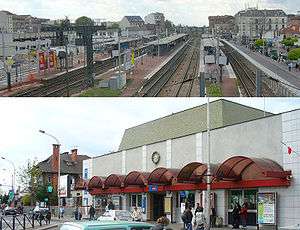
The commune is traversed by the main railway line from Paris to Soissons, Laon, and Hirson which serves the Aulnay-sous-Bois railway station where all buses and semi-direct services of ![]()
![]() (Roissy and Mitry-Mory) and the Transilien Paris to Crépy-en-Valois
(Roissy and Mitry-Mory) and the Transilien Paris to Crépy-en-Valois ![]()
![]() (connecting with TER Villers to Cotterêts/Soissons/Laon) stop and it is the terminus of the
(connecting with TER Villers to Cotterêts/Soissons/Laon) stop and it is the terminus of the ![]()
![]() line. The station has a park and ride with a parking fee.
line. The station has a park and ride with a parking fee.
Since November 2006, the classic commuter train the Ligne des Coquetiers (The Egg-cups line) between Aulnay-sous-Bois to Bondy has been replaced by a Tram-train ![]()
![]() that takes the same route and allows connection to the
that takes the same route and allows connection to the ![]()
![]() and
and ![]() . Two branches are planned: the first to Clichy-sous-Bois and Montfermeil on the Gargan heights; the second towards Garonor through Rose-des-Vents and the N370 to the heights of Rougemont-Chanteloup.
. Two branches are planned: the first to Clichy-sous-Bois and Montfermeil on the Gargan heights; the second towards Garonor through Rose-des-Vents and the N370 to the heights of Rougemont-Chanteloup.
Between September 2009 to January 2011, the Aulnay-sous-Bois station ![]()
![]() has had work done to allow access to all platforms for disabled persons including: the development of four lifts, the rehabilitation of the railway station and underpasses, and the installation of new lighting. Aulnay-sous-Bois station
has had work done to allow access to all platforms for disabled persons including: the development of four lifts, the rehabilitation of the railway station and underpasses, and the installation of new lighting. Aulnay-sous-Bois station ![]()
![]()
![]()
![]()
![]()
![]() is also served by bus routes:
is also served by bus routes:
-
 RATP 251
RATP 251 -
 TRA 605 607a 613 614 615 616a 616b 617 618 627 637 680
TRA 605 607a 613 614 615 616a 616b 617 618 627 637 680 -
 Autobus du Fort 702
Autobus du Fort 702 -
 CIF 15
CIF 15 -
 RATP N140
RATP N140
Villepinte Station ![]()
![]() is located halfway between Aulnay-sous-Bois and Villepinte and it provides access to the district of Rose des Vents. Villepinte station is served by buses: TRA 609 615 617 642 683(RER) (B)(BUS)
is located halfway between Aulnay-sous-Bois and Villepinte and it provides access to the district of Rose des Vents. Villepinte station is served by buses: TRA 609 615 617 642 683(RER) (B)(BUS)
In 2023 a station on line 16 in the Grand Paris Express project is planned north of the commune on the embankment of the former N2 road. Its platforms will be at a depth of 15 metres.[3][4]
Bus
The city is served by various bus networks:
 RATP 148 251 350
RATP 148 251 350 TRA 605 607a 607b 609 610 613 614 615 616a 616b 617 618 627 634 637 680 683 684 686
TRA 605 607a 607b 609 610 613 614 615 616a 616b 617 618 627 634 637 680 683 684 686 Autobus du Fort 702
Autobus du Fort 702 CIF 1 15 32A 43 44 45 93 100
CIF 1 15 32A 43 44 45 93 100-
 RATP N42 N140
RATP N42 N140
In the medium term, it is proposed the creation of a "transverse" line by merging ![]() TRA 614 627 637 lines. In addition, it is also planned to create a circular line to connect different parts of the city to avoid "reloading" (a change of bus) for trips between all economic areas of the city and its public facilities.
TRA 614 627 637 lines. In addition, it is also planned to create a circular line to connect different parts of the city to avoid "reloading" (a change of bus) for trips between all economic areas of the city and its public facilities.
Taxi stand
There is a taxi rank at Aulnay-sous-Bois station .
Air transport
Aulnay-sous-Bois is located 5 km from Charles de Gaulle Airport. The airport can be reached by ![]()
![]() (4 stations) or by the A1 and A3 autoroutes.
(4 stations) or by the A1 and A3 autoroutes.
Toponymy
"Aulnay" is a common French toponym and may derive from the Medieval Latin alnetum meaning "alder grove" after the alder trees (French: aulnes) which covered Aulnay-sous-Bois in ancient times.An alternative derivation is that Aulnay takes its name from its location in pagellus alnetenis - Aulnaye Country
Aulnoye or Aunois was a small agricultural area in Île-de-France. It included a dozen villages and hamlets scattered between thickets, meadows and woods. The village was surrounded by the Forest of Bondy which covered most of the north-east of Paris.
The location previously bore the names Aunay, Aunais, Anay, Aunoye, Aulnaye, Aulnay-la-Fosse, Aulnay-en-France (15th century), becoming Aulnay-lès-Bondy (i.e. "Aulnay by Bondy") in 1787. The commune was renamed Aulnay-sous-Bois (i.e. "Aulnay by the woods") on 5 January 1903 in reference to the ancient Forest of Bondy. Other nearby commune names (Clichy-sous-Bois, Les Pavillons-sous-Bois, and Rosny-sous-Bois) also refer to the same forest.[5]
History
The area was originally settled around 6000 BC (remains found in the Valley of Sausset). Between the 4th and 2nd centuries BC, farmers living around a "villa" belonging to Sabinus - the Savigny Farm. Two places independent from the parish of Saint Sulpice were Savigny and Nonneville which were attached to the current village. Until the 15th century the lords bore the name of d'Aulnay. The lord Jacques Coitier passed succession to his heirs through his nephew to the Gourgues family. The Canal de l'Ourcq was dug during the Napoleonic period to facilitate relations with Paris. Excavation began in 1803 and the canal was opened between Paris and Claye in 1813.
The register of city council meetings shows that 13 May 1814 was the first Prussian occupation of the village. There were also Prussian occupations in 1814 and 1870. Over a long period houses were destroyed and fields remained deserted. On 15 August 1838 a postal boat service was started on the Canal de l'Ourcq from Paris to Meaux. This service stopped in 1849. In 1875 the French Northern Railway opened a station on the new Paris to Soissons line. The rise of Aulnay was largely due to this event. In 1883 the Parc district began to emerge in the south from a fragment of the Forest of Bondy. In the years which followed cohabitation between the rural community of Vieux-Pays (Old Country) and the more urban community of Parc was difficult. There was even talk of cutting the city in two: Aulnay-les-Bondy for Vieux-Pays and Aulnay-sous-Bois for Parc. The population of Aulnay rose from 780 inhabitants in 1885 to 1,012 in 1886. In 1896 the municipal council was mostly made up of inhabitants of Parc but undertook the development of the entire community of Aulnay. A school, a post office, streets, and bridges were built in the south. The creation of "worker trains" by the French Northern Railway attracted many workers to acquire land. Large properties began to fragment. Parc was sold in lots. Tempted by the greenery on the outskirts of Paris, Parisians bought land and transformed the place into a holiday and residential area.
At the beginning of the 20th century Aulnay grew through accentuation on rail traffic and installation of industries. On 5 January 1903, the city became Aulnay-sous-Bois. In September 1914 Aulnay was saved from German military occupation by the counter-offensive during the First Battle of the Marne. In 1924 the Radiator Company commenced operation and provided employment for 2,300 workers. Other small mechanical or chemical industries also moved to Aulnay. Between 1920 and 1931 most of the housing estates were completed. In 1935 the population of the housing estates represented approximately 40% of the total population of Aulnay. In 1955 the large rural area in the north of the commune began to urbanize: large multi-family housing estates were planned and built. In 1962 the first group of buildings at Merisiers was built.
In 1969 and 1970 a housing zone of 3,000 housing units was built in the district of Rose des Vents. In 1971 the Citroën company opened its first factory in the Paris region north of the city. By 1985 Aulnay was completely urbanized. At that date the extension of the northern part and the establishment of industrial zones was complete. Many facilities were added in the districts and gave the city its present face.
Heraldry
 |
Blazon: Or, an alder eradicated proper. |
Politics and Administration

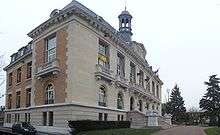
Administration
Since the French canton reform, which came into effect in March 2015, Aulnay-sous-Bois forms one canton: Canton of Aulnay-sous-Bois.
The city is part of the Syndicat d'équipement et d'aménagement des Pays de France et de l'Aulnoye (Facilities and development association of Pays de France and Aulnoye) (SEAPFA).
Administrative changes
Until 1787, the parish of Aulnay was part of the province of Île-de-France, Prévôté, Généralité, Élection de Paris, Subdélégation de Saint-Denis. In 1787, during the formation of the department of Saint-Germain, the village of Aulnay was within the jurisdiction of Gonesse. In 1790 Aulnay was part of the department of Seine-et-Oise, of the canton and district of Gonesse
In 1801 Aulnay became Aulnay-lès-Bondy and was part of the arrondissement of Pontoise. In 1903 Aulnay-lès-Bondy became Aulnay-sous-Bois. The first Canton of Aulnay-sous-Bois was founded in 1922 and included Blanc-Mesnil, Sevran, Villepinte, and Tremblay-les-Gonesse. From 1964 the city formed a Canton of Aulnay alone. Aulnay-sous-Bois, previously under the Department of Seine-et-Oise and the arrondissement of Pontoise, was attached to the new department of Seine-Saint-Denis, Arrondissement of Le Raincy, under the Act of 10 July 1964. This reform came into force on 1 January 1968. Between July 1967 and March 2015, Aulnay-sous-Bois was divided into two separate electoral districts and had two councillors.
List of Successive Mayors[6]
The French municipal elections, 2008, in Aulnay-sous-Bois were annulled on 2 October 2008 by the Administrative Court of Cergy-Pontoise due to putting up posters in the night before the second round of municipal elections.[7] An appeal was brought before the Council of State and the municipal council and the elections in March 2008 remained in place until the court's decision.[8] The elections were finally validated after the decision of the court.
| From | To | Name | Party | Position |
|---|---|---|---|---|
| 1787 | 1791 | François Noël Chartier | ||
| 1791 | 1792 | Christophe Bazureau | ||
| 1792 | 1795 | Pierre Coqueret | ||
| 1795 | 1798 | Louis Delacourt | ||
| 1798 | 1799 | Louis Boileau | ||
| 1799 | 1800 | Pierre Andelle | ||
| 1800 | 1808 | François Chartier | ||
| 1808 | 1830 | Auguste Fançois de Gourgues | ||
| 1830 | 1833 | Félix Fessard | ||
| 1833 | 1840 | Jean Benoît Ciquard | ||
| 1840 | 1844 | François Jérôme Langlois | ||
| 1844 | 1860 | Louis Antoine Dalleux | ||
| 1866 | 1893 | Dominique Armand de Gourgues | ||
| 1893 | 1896 | Marie Alexandre Depre | ||
| 1896 | 1905 | Claude Buchet | ||
| 1905 | 1919 | Isidore Nerat | ||
| 1919 | 1924 | Jules Princent | ||
| 1925 | 1928 | Albert Libs | ||
| 1928 | 1930 | Arthur Chevalier | ||
| 1930 | 1932 | Charles Dordain | ||
| 1932 | 1935 | Louis Poupon | ||
| 1935 | 1939 | Maurice Nilès |
- Mayors from 1939
| From | To | Name | Party | Position |
|---|---|---|---|---|
| 1939 | 1941 | Henri Fourquez | ||
| 1941 | 1944 | Charles Drocourt | ||
| 1944 | 1944 | Jean Perlis | ||
| 1944 | 1944 | Narcisse Renaudot | ||
| 1944 | 1945 | Maurice Nilès | PCF | |
| 1945 | 1947 | Pierre Scohy | PCF | |
| 1947 | 1959 | Fernand Herbaut | SFIO | |
| 1959 | 1964 | Robert Courtat | SFIO | |
| 1964 | 1965 | Maurice Cadot | SFIO | |
| 1965 | 1971 | Louis Solbès | PCF | |
| 1971 | 1977 | Robert Ballanger | PCF | |
| 1977 | 1983 | Pierre Thomas | PCF | |
| 1983 | 1983 | Gilbert Seron | ||
| 1983 | 2003 | Jean-Claude Abrioux | UMP | |
| 2003 | 2008 | Gérard Gaudron | UMP | |
| 2008 | 2014 | Gérard Ségura | PS | |
| 2014 | 2020 | Bruno Beschizza[9] | UMP |
(Not all data is known)
Demographics
According to INSEE (2004), the average household income is €15,000. Much of the upper-middle class lives in the south of the town. The canton of Aulnay-Sud has a very different character from the canton of Aulnay-Nord, owing to differences in education and wages. For example, the average income in the south of the town is around €20,000 - €25,000 (2004), much higher than the national average of €15,000 (2004). Furthermore, the north (Aulnay-Nord) has a high number of HLM (public housing). There is even a political divide, with Aulnay-Nord Canton sending a Socialist representative (Gerard Segura) to the Council-General for the Seine-Saint-Denis Department, but Aulnay-Sud a conservative (Jacques Chaussat).
Immigration
| |||||||||||||||||||
As of circa 1998 there were about 3,000 persons of East and Southeast Asian origin in Aulnay, while there were a total of 6,000 living in the area around Aulnay. Most of them were of Cambodian origin, including those with and without Cambodian citizenship. The commune also had an above-average number of persons of Laotian origin, including those with and without Laotian citizenship. Ethnicities included Khmer people, Lao people, and Overseas Chinese.[10]
Many Asian families in Aulnay arrived in the period 1982 through 1990. As of circa 1998 most of the Asians in Aulnay resided in Les Trois Mille, a social housing estate, mainly due to a social agency wanting to increase ethnic diversity in a predominately North African area.[10]
As of circa 1998 there were about 1,280 Asians in the Aulnay area active in the job market, and about 100 of the ethnic Chinese in the Aulnay area worked in Belleville and the 13th arrondissement of Paris. Even though Citroen factories are in proximity to Tres Trois Mille, relatively less than 88 of the Asians in Aulnay work in the factories.[10]
Political trends and results
For the 2007 elections Aulnay-sous-Bois was one of 82 communes[11] with more than 3,500 people to use voting machines. They have been used for all polling stations since the 2004 European elections. The municipal council elected in 2008 decided to return to vote by paper ballots.
Twinning
Aulnay-sous-Bois has twinning associations with:[12]
 Rufisque (Senegal) since 2011.
Rufisque (Senegal) since 2011. Al-Ram (Palestine) since 2010.
Al-Ram (Palestine) since 2010.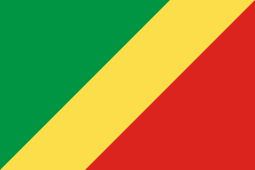 Abala District (Republic of the Congo) since 2003.
Abala District (Republic of the Congo) since 2003.
Demography
In 2010 the commune had 82,120 inhabitants. The evolution of the number of inhabitants is known from the population censuses conducted in the commune since 1793. From the 21st century, a census of communes with fewer than 10,000 inhabitants is held every five years, unlike larger towns that have a sample survey every year.[Note 1]
| 1793 | 1800 | 1806 | 1821 | 1831 | 1836 | 1841 | 1846 | 1851 |
|---|---|---|---|---|---|---|---|---|
| 580 | 536 | 563 | 513 | 577 | 584 | 611 | 622 | 637 |
| 1856 | 1861 | 1866 | 1872 | 1876 | 1881 | 1886 | 1891 | 1896 |
|---|---|---|---|---|---|---|---|---|
| 646 | 646 | 680 | 627 | 765 | 780 | 1,012 | 1,306 | 1,878 |
| 1901 | 1906 | 1911 | 1921 | 1926 | 1931 | 1936 | 1946 | 1954 |
|---|---|---|---|---|---|---|---|---|
| 2,829 | 4,417 | 7,141 | 11,928 | 21,636 | 31,426 | 31,763 | 32,356 | 38,534 |
| 1962 | 1968 | 1975 | 1982 | 1990 | 1999 | 2006 | 2010 | - |
|---|---|---|---|---|---|---|---|---|
| 47,507 | 61,521 | 78,137 | 75,996 | 82,314 | 80,021 | 81,200 | 82,120 | - |
Sources : Ldh/EHESS/Cassini until 1962, INSEE database from 1968 (population without double counting and municipal population from 2006)
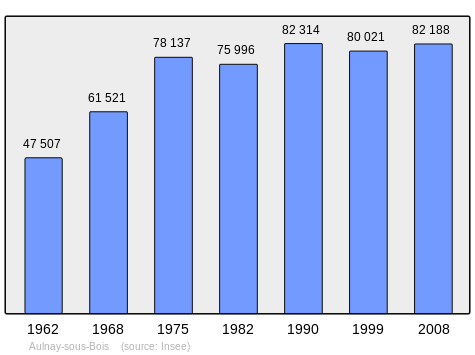
The Centre for Strategic Analysis conducted a study on the city: the extract below tends to reflect a bad reputation, not necessarily deserved in all its aspects.
"It would be wrong to present Aulnay simply as a disadvantaged commune. It is a city which is composed in part of professions, middle, and senior management. It is also a city with important economic resources - three economic centres are located there: a PSA Peugeot Citroën factory, a L'Oréal group centre, and a Garanor centre of economic activity..."
In 2011 Aulnay-sous-Bois was the 55th most populated commune in France.[13]
Economy
The city had good growth due to companies like L'Oréal and PSA Peugeot Citroën being located there. There are concerns, however, resulting from the departure of Xerox France[14] and the fears that plague the Citroën plant.[15]
Statistics
Aulnay-sous-Bois had 3,398 business enterprises in 2012 and 622 new enterprises were created in that year.[16]
Large companies
- Aulnay-sous-Bois is home to the largest company in the department: Peugeot-Citroën Aulnay with over 5,000 employees and a production of about 400,000 vehicles per year.

- L'Oréal is located in the commune (a street and a pathway in the city bear the name of its founder Eugène Schueller), with a factory in the north and a research centre in the south.
- The Garonor logistics park has many freight companies.
- The O'Parinor regional mall (see shopping).
The city itself employs nearly 2,400 people and thus constitutes one of the largest employers in the town (see Administrative Staff).
| Name | Activity | Turnover (000s) | Website |
|---|---|---|---|
| XEROX-FRANCE (Xerox France left Aulnay-sous-Bois in 2007[14]) | Office equipment & IT | €996,565 | www.xerox.fr |
| GAUX PHARMA DEPOTS | pharmaceutical warehousing | €410,951 | |
| SOPROREAL (L’ORÉAL) | Cosmetics | €140,200 | www.loreal.fr |
| XEROX DOCUMENT SUPPLIES | Office consumables | €68,707 | |
| POWER CONTROLS-FRANCE (VYNCKIER) | Electrical equipment | €58,888 | |
| FREIGHT LOGISTICS | Freight Transport | €32,759 | |
| GARONOR (AGF) | Warehousing | €30,819 | |
| PARIS NORD AUTOMOBILES | Auto Dealers | €30,265 | |
| SOLDIS | Coatings | €28,956 |
Automotive production
In May 1973 it was reported that the first Citroën DS had emerged from the production line at Citroën's new plant at Aulnay.[18] The plant has subsequently produced various Citroën and Peugeot models and has on occasion hit the headlines as a focus of industrial strife. On 12 July 2012 PSA Peugeot Citroën announced that it will permanently close the Aulnay-sous-Bois plant due to overcapacity.[19]
Aulnay is also the site of the subterranean Citroën repository of Citroën archives and 370 Citroën cars produced over the years. The repository, established in 2002,[20] is not open to the public although members of Citroën enthusiasts' clubs and other important visitors are occasionally granted access to it.
Shops
The O'Parinor regional mall is located in the commune.

There is an Intermarché Hypermarket in Chanteloup.
There is at least one market every day from Tuesday through Sunday:
- At Galion in the heart of Rose des Vents: Tuesdays, Fridays, and Sundays
- At Vieux-Pays: Wednesdays and Saturdays
- On the Boulevard de Strasbourg: Tuesdays, Thursdays, and Sundays
Two markets were held on the Place des Etangs and in the Ambourget district without success.
Culture and heritage
Civil heritage
The commune has a number of buildings which contain items registered as historical objects:
- The Savigny Farm contains a Group sculpture: Saint Antoine (14th century)
 [21]
[21] - The Church Square contains 12a Group sculpture: Saint Antoine (14th century)
 [21]
[21]
Religious heritage
The commune has one religious building that is registered as a historical monument:
- The Church of Saint-Sulpice (12th century).
 [22] The Church contains many items that are registered as historical objects:
[22] The Church contains many items that are registered as historical objects:
- 12 Anagogic Stained glass windows (20th century)
 [23]
[23] - 2 Tombstones of Elisabeth Guibillon and Jeanne Berson (17th century)
 [24]
[24] - A Painting: Christ and Saint Mary Magdalene (18th century)
 [25]
[25] - A Painting: Saint Vincent de Paul (19th century)
 [26]
[26] - A Painting: The meal of Emaus (1711)
 [27]
[27] - A Tombstone of Thomas Michel (1665)
 [28]
[28] - A Tombstone of Jacques Longer (1711)
 [29]
[29] - A Tombstone of Louis Le Clerc de Cottier (1679)
 [30]
[30] - A Tombstone of Robert la Nesle (1745)
 [31]
[31] - A Painting: The meal of Emaus (1713)
 [32]
[32] - A Painting: Saint Roch and the plague (18th century)
 [33]
[33] - A Silver plate and 2 Silver Cruets (1826)
 [34]
[34] - A Statue: Virgin and Child (17th century)
 [35]
[35] - A Console (18th century)
 [36]
[36] - 2 Sculptures: Angels seated holding a shield (18th century)
 [37]
[37] - 10 decorative windows (19th century)
 [38]
[38] - 2 stained glass windows of Saint Dominique and Saint Roch (1865)
 [39]
[39] - 2 stained glass windows of the Assumption and the Resurrection (1866)
 [40]
[40]
- 12 Anagogic Stained glass windows (20th century)
Other churches contain items registered as historical objects:
- The Chapel of Saint-Paul d'Ambourget contains abstract stained glass windows (20th century)
 [41]
[41] - The Church of Saint-Joseph at 57 Avenue de la Croix-Blanche contains:
- 10 stained glass windows depicting saints (1934-1940)
 [42]
[42] - 2 stained glass windows of Saint Adrien and Saint Martha (1934)
 [43]
[43] - 2 stained glass windows of Saint Mary (1942)
 [44]
[44] - 2 stained glass windows of Bon Pasteur and the Virgin and Child (20th century)
 [45]
[45] - A stained glass window consecrated at Saint Joseph (1920)
 [46]
[46]
- 10 stained glass windows depicting saints (1934-1940)
- The Church of Saint-Pierre of Nonneville at 54 Rue de Reims contains:
Parks
Aulnay has 153 hectares of green space of which these are the main ones:
- Sausset departmental Park traversing both Aulnay-sous-Bois and Villepinte (200 hectares - the 2nd largest in the department)

- Robert Ballanger communal park (29 hectares), with a lookout where the Eiffel Tower and Sacré-Cœur can be seen

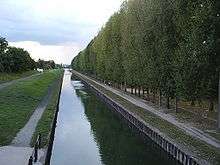
- Dumont Park, avenue Dumont
- Gainville Park, park of swans, rue de Sevran (7.6 hectares), next to the Gainville House - the oldest house in Aulnay (dating to the 17th century)
- Émile Zola Park, boulevard Émile Zola (4.4 hectares)
- Faure Park, circular road (9 hectares)
- Bigottini Park, avenue de la Croix-Blanche
- Honoré Daumier Rose Garden, avenue du Maréchal juin (8 hectares and 2,500 rose plants)
- Banks of the Canal de l'Ourcq
- Serres municipales, rue Auguste Renoir
Facilities
Cultural Facilities

- The Jacques Prévert Theatre and cinema is a multi-cultural centre that offers diverse live entertainment programming for both adults and young audiences. It can accommodate 100,000 spectators annually and offers throughout the year: theatre, dance, songs, and opera. It is also a cinema. The two theatres (the largest of which accommodates 700 seats) show twenty films per month.
- The CAP is a cultural facility dedicated to contemporary music and all kinds of music from around the world. It is a venue with a theatre with a capacity of over 500 people and holds about four to five concerts per month. It also offers education through 17 workshops for instrumental practice at every level: percussion, string instruments, wind instruments, guitar etc. as well as in vocal technique and gospel singing. Supporting young talent is also one of the objectives of the CAP. Three rehearsal studios and a resource centre are available for amateur musicians to help them realize their projects, information on contracts, intermittent status of the show, the addresses of places to play, and many other functions.
- The Conservatory of Music and Dance is a departmental branch (CRD) which offers individual and group courses for children from the age of 4. It is possible to choose from: Accordion, Viola, Bassoon, Clarinet, Harpsichord, Bass, Horn, Flute, Guitar, Harp, Oboe, Piano, Percussion, Saxophone, Trombone, Trumpet, Tuba, Violin, and Cello.
- The Dance Centre of Galion welcomes and supports youth in their artistic activities with three rehearsal studios, work experience, and regular courses. It is recognized as a Centre of Resources for Amateur Dancing Practice in Ile-de-France. To promote dance in all its forms it organizes meetings between different experiences, expressions, and supports the creation of young choreographers.
- The Claude Monet School of Art is one of the largest non-degree schools in France. It is open to children and adults. Twelve teachers educate nearly 800 apprentice artists every year and introduce techniques from different artistic disciplines to them: drawing, painting, printmaking, tapestry, photography, ceramics, sculpture, cartoon, graphic design, and art history. Their teaching mission is completed by the design, organization, and presentation of exhibitions promoting the encounter between the public and works of art.
- The CREA is a unique arts educational structure in France. It is established at the Jacques Prévert theatre and plans to build a centre in Vieux Pays. Its director, Didier Grosjman, and his team have realized many projects with schools, colleges, autistic children, students, and teachers. Four "permanent" courses have been offered since its inception 25 years ago:
- L'éveil (Awakening) for children between 7–8 years old
- avant-scène (Forestage) for those 8 to 11 years old
- chœur de scène (choir stage) for children 10–18 years who play at the Opéra Bastille and Opéra de Vichy
- Créa'tures, the choir of young adults.
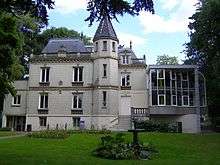
- 5 libraries and a Mediabus:[49]
- 'Dumont library, Boulevard du General Gallieni
- Guillaume Apollinaire Library, rue Turgot
- Alphonse Daudet Library, rue du Hameau
- Jules Verne Library, rue du Limousin
- Elsa Triolet Library, Saturn Street
- A Sound library, rue Roger Contensin
Cultural events and festivals
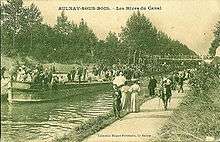
In 1981 and 1982, Aulnay-sous-Bois was a stage town for the 68th and 69th Tour de France during the 10th stage (Le Mans-Aulnay-sous-Bois) in 1982 and for the 20th stage in 1982 (Sens-Aulnay-sous-Bois).
Every winter an outdoor skating rink (600 metres square in 2006-2007) is installed at the Vieux Pays Farm.
Every Easter Monday there is a Spring Fair that combines antiques, a flea market, and a garage sale. It brings together about 1,500 exhibitors between Vieux Pays and the Place du General Leclerc.
The Jacques Prévert Theatre and cinema stages Les Panoramiques festival in May - a festival of artistic practices for amateurs. It unites for one week different theatrical companies of children, adolescents, and adults who present their creations on stage.
Every year in November is the Aulnay All Blues festival.[50]
In early June there is the Festival of Towns in Flower and Cycling in Gainville (Parc des Cygnes) Park.
A Festival of Military Music is scheduled on the second Saturday of June. Groups from several European countries are invited. In the morning a parade is held in the city from Dumont Park followed by an outdoor concert at Dumont Park. In the afternoon there is a parade from the Vieux Pays Farm and a concert in the Pierre Scohy gymnasium.
The Festival of the Canal de l'Ourcq is held in mid-June between the Pavilions-sous-Bois port and the Jardins Perdus Gateway.
The traditional Festival of the Tree takes place for two days in early November at Dumont Park. There are organized exhibitions and workshops for children focused around trees, nature, and wildlife. The adventure trail from tree to tree is free for all.
The festival of hip-hop, H2O (A Hip Hop Organization), is organized by the Centre de Danse du Galion in partnership with the Jacques Prévert Theatre and cinema and the current music scene Le Cap in December. Over the past 10 years it has brought together the avante-garde of the French hip-hop scene.
The Battle VNR, every last Sunday of May, is a break-dance hip-hop event which has been running since 2002.
The city hosted the 2012 Boxing Championship of France.[51]
Les Futuriales Festival takes place every year in Dumont Park since 2010. It has for its theme literature of the imagination and has more than 60 authors in one day.[52] It is co-organized by the Librarie Folies d'Encre and the network of libraries.
Education
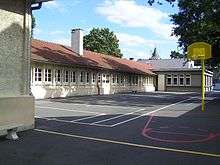
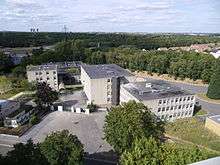

Education of very young children:
- 6 full-time collective home crèches
Public schools:[53]
- 23 public nursery schools/preschools
- 30 public primary schools
- At the end of the 2007-2008 year the Bougainville elementary school was closed - Le parisien, edition 93 of 3 September 2007
- 7 public junior high schools
- a project for a 7th school in the south is in progress
- 2 public secondary schools
- Lycée polyvalent régional Voillaume
- Lycée Jean Zay
Private schools:[53]
- 1 private preschool elementary, junior and senior high school: Institution l’Espérance
- 1 private preschool, elementary school and senior high school: Protectorat Saint-Joseph
Health

There are three health facilities in Aulnay-sous-Bois:
- The Centre Hospitalier Robert Ballanger: the inter-communal hospital for Aulnay-sous-Bois, Villepinte, and Sevran (1750 employees).[54]
- The 'René Muret-Bigottini Gerontology Hospital straddles the border between Sevran and Aulnay-sous-Bois.
- The 'Clinic of Aulnay, Private Hospital of east Paris
Sports
- "Coursailles" Olympic Swimming Stadium (up to 2700 people entering per day)[55]
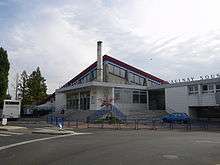
- 8 gymnasiums
- Stadiums:
- Velodrome
- 5 multi-purpose stadiums
- 2 Sports Complexes
- 3 tennis complexes

Worship

- Catholic worship:
- Church of Saint-Sulpice, Rue de Sevran.
- Church of Saint-Pierre de Nonneville, rue de Reims
- Church of Saint-Paul of Ambourget, Rue du 8 Mai 1945
- Church of Saint-Jean, gallerie Surcouf
- Chapel of Notre-Dame du Coudray, Rue Francis Creno
- Church of Saint-Joseph Church (including Christmas and every Sunday at 9:30 am it offers Mass in Polish), avenue de la Croix Blanche.
- Protestant worship: Temple of the Reformed Church of France, Boulevard Gourgues.
- Muslim worship:
- Cultural Association of Muslims of Rose des Vents, rue Auguste Renoir
- Cultural Association of Muslims of Aulnay, Rue de l'Esprit
- Cultural Association of Muslims of Mitry, Allée des Cyprès
- Jewish worship:
- Synagogue, Allée du Clermont-Tonnerre
- Synagogue, Rue Dupuis
Notable people linked to the commune
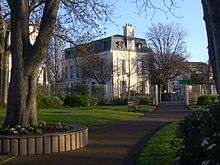
- Claude Louis Berthollet, inventor of Eau de Javel, lived in Aulnay-sous-Bois from 1789 to 1799 in the Gainville House.
- Guy Decomble, actor, born on 12 November 1910.
- Paul Éluard, writer and poet, lived in Aulnay-sous-Bois from 1903 to 1908. He went to Parc school.
- Jack Harris born Jacques Estevant, composer, French novelist and poet, 275th Universal Peace Ambassador, born in 1940. He went to the following schools: Duguesclin in 1946, Paul Bert from 1947, then Nonneville, and finally an Industrial Complementary Course at Nonneville where he was an apprentice fitter from 1954 to 1957.
- André Laude, French poet, lived in Aulnay-sous-Bois.
- Christian Morel de Sarcus, writer and poet, born in Aulnay.
- Jules Princet, man of letters, creator of the Théâtre aux Champs, (?-1924) mixed with actors and was mayor from 1919 to his death in 1924.
- Waldteufel Louis, René, Jean, sons of Émile Waldteufel the composer, lived in Aulnay in 1928 at 10 rue André Romand.
- Alou Diarra, Footballer.
- Jean-Louis Mandengue, Heavyweight Boxing Champion of France.
- Amine, singer.
- Sefyu, rapper, won a gold record for his album Suis-je le gardien de mon frère? (Am I my brother's keeper?) (2008) and winner of a Victoires de la Musique award in 2009.
- Lartiste, rapper.
- Saïd Taghmaoui, film actor.
- Olivier Dacourt, football player for Inter Milan.[57]
- Boukary Dramé footballer at FC Sochaux.
- Moussa Sissoko, footballer at Newcastle United.
- Nicolas Douchez footballer at Paris Saint Germain.
- Benlarbi Rabah former footballer, Assistant coach in UAE, assistant to Philippe Troussier at Shenzhen Ruby, China.
- Joachim Ekanga-Ehawa, basketballer at Paris-Levallois Basket.
- Ali Traoré, basketballer at ASVEL Lyon-Villeurbanne.
- Mathieu Sail, footballer at Paris Saint-Germain Football Club.
- Kevin Trudo, footballer at Anconne.
- Teddy Tamgho, world champion and world record holder for the indoor triple jump (2010)
- Thomas Bouhail, silver medalist in Gymnastics Vaulting (2008)
- John Dovi, Heavyweight Boxing champion, National coach for the French Boxing Federation
- Boubakary Diarra, footballer at FC Torino (Italy)
- El Hadji Ba, footballer at Sunderland
- Laurane Dulieu
Bibliography
- Aulnay-sous-Bois, youth of an old country, Jacques Varin, 1982 (French)
- Aulnay-Sous-Bois (History of) Jules Princet, 1936 (reprint 2004), ISBN 2843730546 (French)
See also
Notes
- ↑ At the beginning of the 21st century, the methods of identification have been modified by Law No. 2002-276 of 27 February 2002, the so-called "law of local democracy" and in particular Title V "census operations" allows, after a transitional period running from 2004 to 2008, the annual publication of the legal population of the different French administrative districts. For communes with a population greater than 10,000 inhabitants, a sample survey is conducted annually, the entire territory of these communes is taken into account at the end of the period of five years. The first "legal population" after 1999 under this new law came into force on 1 January 2009 and was based on the census of 2006.
References
- ↑ Inhabitants of Seine-Saint-Denis (French)
- ↑ Aulnay-sous-Bois in the Competition for Towns and Villages in Bloom Archived December 10, 2014, at the Wayback Machine. (French)
- ↑ Information page on Aulnay Station - Société du Grand Paris (French)
- ↑ Presentation at the public information meeting in Aulnay-sous-Bois on 9 December 2013 Société du Grand Paris (French)
- ↑ The Origin of the name "Aulnay", on the commune website, retrieved 21 August 2013 (French)
- ↑ List of Mayors of France (French)
- ↑ Aulnay-sous-Bois: Election annulled, 3 October 2008, Le Figaro website, consulted on 9 October 2008 (French)
- ↑ Aulnay-sous-Bois: Election of the Mayor annulled, 3 October 2008, Le Parisien website, consulted on 9 October 2008 (French)
- ↑ Gwenael Bourdon, For the first time they have endorsed the mantle of the Mayor this weekend - the walkabout of Beschizza, Le Parisien, Seine-Saint-Denis edition, 7 April 2014 (French)
- 1 2 3 Guillon, Michelle. "The Chinese and Chinese Districts in Paris" (Chapter 11). In: Sinn, Elizabeth (editor). The Last Half Century of Chinese Overseas. Hong Kong University Press, 1 January 1998. ISBN 9622094465, 9789622094468. CITED: p. 197.
- ↑ List of 82 communes equipped with voting machines on the ZDNet.fr website (French)
- ↑ National Commission for Decentralised cooperation (French)
- ↑ INSEE - The most populated communes in France Archived July 5, 2014, at the Wayback Machine. (French)
- 1 2 Address of Xérox France at Saint-Denis (French)
- ↑ Peugeot closes an assembly line, Article in La Parisien edition 93 3 July 2007 (French)
- ↑ Entreprises at Aulnay-sous-Bois on Journaldunet.com (French)
- ↑ Classification of enterprises in Ile de France on the lentreprise.com website (archived on Internet Archive) (French)
- ↑ "News: The first Citroen DS has rolled off...". Autocar. Vol. 138 (nbr 4016). 17 May 1973. p. 10.
- ↑ Wall Street Journal 13 July 2012
- ↑ "Neues vom Auto: Heimat duer Citroen-Klassiker". Auto, Motor und Sport. Vol. 2001 Heft 26. 12 December 2001. pp. Seite 16.
- 1 2 Ministry of Culture, Palissy PM93000010 Group Sculpture: Saint Antoine (French)
- ↑ Ministry of Culture, Mérimée PA00079928 Church of Saint-Sulpice (French)

- ↑ Ministry of Culture, Palissy IM93000137 12 Anagogic Stained glass windows (French)
- ↑ Ministry of Culture, Palissy PM93000011 2 Tombstones of Elisabeth Guibillon and Jeanne Berson (French)
- ↑ Ministry of Culture, Palissy PM93000585 Painting: Christ and Saint Mary Magdalene (French)
- ↑ Ministry of Culture, Palissy PM93000584 Painting: Saint Vincent de Paul (French)
- ↑ Ministry of Culture, Palissy PM93000488 Painting: The meal of Emaus (French)
- ↑ Ministry of Culture, Palissy PM93000487 Tombstone of Thomas Michel (French)
- ↑ Ministry of Culture, Palissy PM93000486 Tombstone of Jacques Longer (French)
- ↑ Ministry of Culture, Palissy PM93000485 Tombstone of Louis Le Clerc de Cottier (French)
- ↑ Ministry of Culture, Palissy PM93000484 Tombstone of Robert la Nesle (French)
- ↑ Ministry of Culture, Palissy PM93000009 Painting: The meal of Emaus
(French)

- ↑ Ministry of Culture, Palissy PM93000008 Painting: Saint Roch and the plague
(French)

- ↑ Ministry of Culture, Palissy PM93000007 Silver plate and 2 silver cruets
(French)

- ↑ Ministry of Culture, Palissy PM93000006 Statue:Virgin and Child
(French)

- ↑ Ministry of Culture, Palissy PM93000005 Console
(French)

- ↑ Ministry of Culture, Palissy PM93000004 2 Sculptures: Angels seated holding a shield
(French)

- ↑ Ministry of Culture, Palissy PM93000136 10 decorative windows (French)
- ↑ Ministry of Culture, Palissy PM93000135 2 stained glass windows of Saint Dominique and Saint Roch (French)
- ↑ Ministry of Culture, Palissy PM93000134 2 stained glass windows of the Assumption and the Resurrection (French)
- ↑ Ministry of Culture, Palissy IM93000138 Abstract Stained Glass (French)
- ↑ Ministry of Culture, Palissy IM93000143 10 stained glass windows depicting saints (French)
- ↑ Ministry of Culture, Palissy IM93000142 2 stained glass windows of Saint Adrien and Saint Martha (French)
- ↑ Ministry of Culture, Palissy IM93000141 2 stained glass windows of Saint Mary (French)
- ↑ Ministry of Culture, Palissy IM93000140 2 stained glass windows of Bon Pasteur and Virgin and Child (French)
- ↑ Ministry of Culture, Palissy IM93000139 A stained glass window consecrated at Saint Joseph (French)
- ↑ Ministry of Culture, Palissy IM93000145 10 geometric stained glass windows (French)
- ↑ Ministry of Culture, Palissy IM93000144 Abstract stained glass window (French)
- ↑ The médi@bus of Aulnay-sous-Bois (French)
- ↑ Aulnay All Blues, article in Le Monde, 11 February 2013 (French)
- ↑ Boxing Championship on the commune website (French)
- ↑ The festival of literature of the imagination of Aulnay-sous-Bois (French)
- 1 2 "Les écoles." Aulnay-sous-Bois. Retrieved on September 8, 2016.
- ↑ Robert Ballanger Hospital official website (French)
- ↑ Records of entry at the Aulnay-sous-Bois pool in 2007 (French)
- ↑ Aulnay, land of champions, 28 January 2010, Le Parisien, consulted on 1 September 2010 (French)
- ↑ Page on Olivier Dacourt on the Racing Club de Lens website (French)
External links
| Wikimedia Commons has media related to Aulnay-sous-Bois. |
- Official website (French)
- Aunay on the 1750 Cassini Map
- Aulnay-sous-Bois on the INSEE website (French)
- INSEE (French)
